Paulo D.J. Surface Integrity in Machining
Подождите немного. Документ загружается.


3 Residual Stresses and Microstructural Modifications 101
Rech et al. [37] worked on characterization and modeling of the residual
stresses induced by belt finishing on a AISI52100. A new technological process
consisting of hard turning (HT) followed by abrasive machining, in place of the
widely used method in industry, e.g., hard turning versus grinding has lately been
launched in the automotive industry. Many transmission parts, such as synchroniz-
ing gears, crankshafts and camshafts require superior surface finish along with
appropriate fatigue performance. A comprehensive characterization of part residual
stresses produced in dry turning of a hardened AISI52100 bearing steel using
PCBN tools, and also its modification after a special abrasive finishing operation
such as belt finishing. The residual stresses generated in hard turning or in hard
turning + belt finishing are investigated by two complementary means: an experi-
mental X-ray diffraction characterization after each step of the process, and a fi-
nite-element model of the belt-finishing operation in order to understand better
experimental results. The belt-finishing process improves significantly the surface
integrity by the induction of strong compressive residual stresses in the external
layer and by a great improvement of the surface roughness. In this study the biaxial
residual stress with tangential (σ11) and axial (σ22) components was measured
using the X-ray diffraction method, consisting in the determination of the varia-
tions in peak positions due to distortions of the crystalline lattice.
Figure 3.44 shows profiles of the tangential and axial stress components meas-
ured by X-ray diffractometry after hard turning and after hard turning + belt finish-
ing. For each direction, two pieces have been produced with the same cutting con-
ditions. It is necessary to keep in mind that the precision of the measurements has
been quantified: ±60 MPa.
The two curves corresponding to the two pieces produced with the same condi-
tions reveal that the deviation of residual-stress state is rather high. The shapes of
the curves are similar for both pieces and both directions of measurements. Hard
turning induces tensile stresses in the external layer and as a consequence, there is
a peak of compression in the sublayer.
Figure 3.44. Residual stress profiles below the surface obtained after c-BN hard turning and
belt-finishing operations [37]

102 J. Grum
3.5 Residual Stresses After Milling
Segawa et al. [38] worked on development of a new tool to generate compressive
residual stress within a machined surface with the milling process. The diameter of
the tool is 6
mm, and the tool body is made of high-speed steel. The cutting edges
of the tool remove extra material and the projection pin compresses the machined
surface to make plastic deformation simultaneously with the milling process. Fig-
ure 3.45 shows the schematic view of the machining process using the compressive
residual-stress-generating cutter CCRSG.
They used a plate of rolled aluminum alloy 7075-T651, which had been heat
treated. The size of the specimen was 6
mm × 90
mm × 150
mm. In this finishing
process preparing for the test, a face mill of 85
mm diameter with four carbide in-
serts was used. The milling conditions were: spindle speed of 2200
min
−1
, feed
speed of 298
mm/min, and axial depth of cut of 0.1−0.2
mm. In the final process the
axial depth of cut was decreased to 0.02−0.03
mm. Due to the care taken in the
preparation of the test workpiece, the effects of this premachining process were
considered negligible.
The residual stress on the specimen surface was measured using the X-ray dif-
fraction method. The measured value range was −8 to 100
MPa.
Figure 3.46 shows residual-stress profiles below the depth of the machining sur-
face with the CRSG cutter. On the machined surface, the residual stresses in dry
and in all cutting fluid conditions were −100 and −200
MPa. It can be seen that the
compressive residual stress below the surface is higher than on the surface. Clearly,
the compressive residual stress of the machined surface in these conditions is
higher than that in oil cutting conditions.
The peak of the compressive residual stress is observed at a depth of 0.05
mm
from the surface. The peak value was observed at −400 and −350
MPa. In dry and
in oil conditions, respectively. At a depth of 0.05
mm below a depth of 0.5
mm
from the surface. Compressive residual stress improves the fatigue strength and
resistance to stress-corrosion cracking. The highest value of compressive residual
stress was generated below the surface. The fatigue life of the machined compo-
Figure 3.45. Schematic view of the machining state using the CCRSG cutter [38]
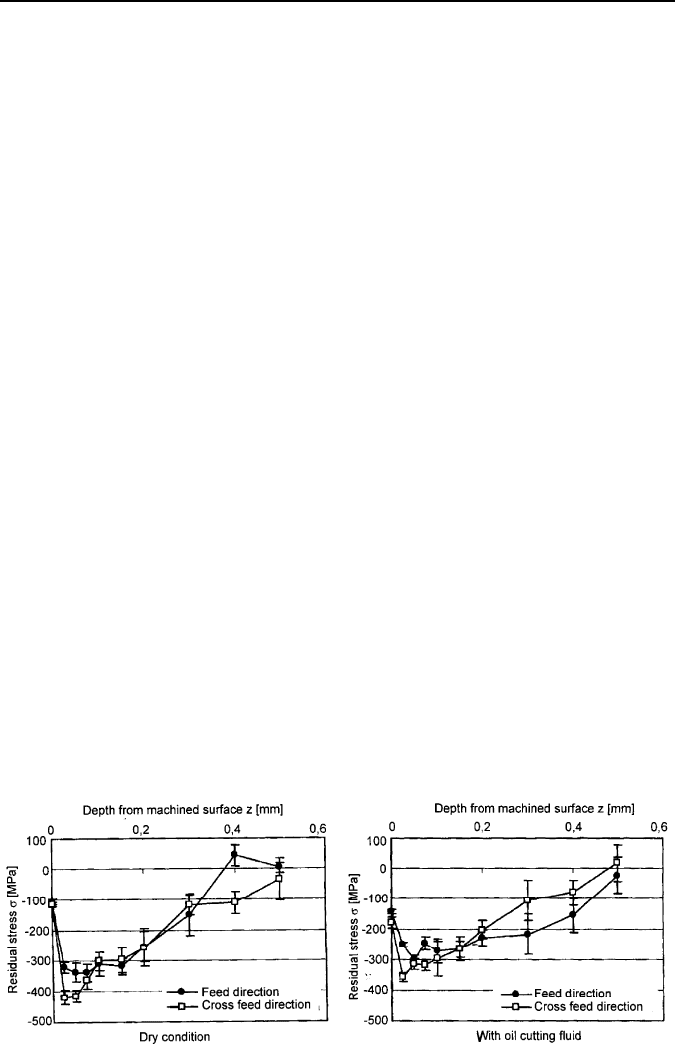
3 Residual Stresses and Microstructural Modifications 103
nent with this tool would be extended regarding residual stress fields.
Li et al. [39] carried out an FEM study on residual stresses induced by high-
speed end milling of hardened steel SKD11. Milling of hardened steel SKD11 is
usually a finishing process, therefore a stable cutting process must be guaranteed
first. Residual stresses were studied in this paper with a finite-element method
(FEM) for its significant influence on the quality of machined part. A two-dimen-
sion (2D) fully thermomechanical coupled finite-element (FE) model was employ-
ed to evaluate residual stress in a machined component. The same cutting tools
were employed to model continuous feed milling process. Residual-stress profiles
were obtained after end-milling and stress-relaxation stages. The predicted resid-
ual-stress profiles corresponded to experimental results.
Hardened steel SKD11 has wide applications in the mold and die industry. It is
also a difficult-to-cut material due to its high strength and hardness that varies from
60 to 62 HRC. With the development of cutting tools, hard milling is becoming
a feasible approach to traditional grinding and electron discharge machining
(EDM) for its high machining efficiency. However, hard milling is often used as a
finishing process, a stable cutting process should be guaranteed to obtain satisfied
machining precision. Residual stresses existing in a machined product have a major
influence on the quality of the machined part, in particular, its fatigue life and cor-
rosion resistance. Predicting the distribution of residual stress induced by cutting
process is very important.
As evidence of the ability of the simulation procedure to model residual stress,
a comparison was carried out between FEM predictions and experimental meas-
urements. Predicted residual-stress profiles were obtained until the workpiece was
unloaded and left to cool down to room temperature. Figure 3.47 shows the com-
parison of the two residual stress between FEM and experiment. Although both of
the curves do not match exactly, the FE model correctly estimates the in-depth RS
profiles showing the same trend and starting with almost the same surface value as
the experimental one.
In general, an exact match between FEM and experimental results could not be
expected because of the different sources of errors in each of them. The main
source of errors encountered in FEM modeling could be summarized as follows
(a) (b)
Figure 3.46. Residual stress profiles measured from the machined surface: (a) dry condition;
and (b) with oil cutting fluid [38]
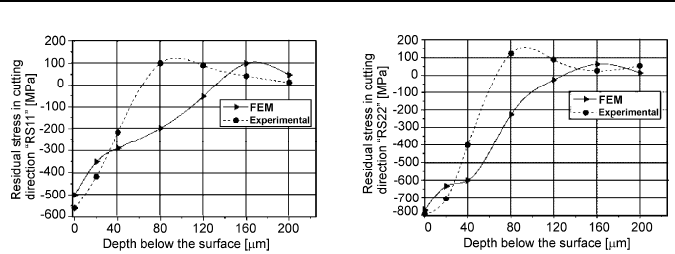
104 J. Grum
material modeling, numerical integration and interpolation, assumed friction condi-
tion. Furthermore, simulation runs with a constant tool edge radius, while practi-
cally the tool edge may wear out or break down during cutting. On the other hand,
the main sources of errors in experimental results are those encountered in resid-
ual-stress measurement, especially in measuring the etched depth. Besides, the
actual workpiece material is not homogeneous, while it is considered to be a pure
homogenous material in the FEM simulation. However, it is important to notice
that both FEM and experiments of the profiles show a state of equilibrium between
tensile and compressive residual stress, as it should be.
3.6 Residual Stresses and Microstructures at the Surface After
Grinding
Brinksmeier [40] presented the influence of process parameters quantities in grind-
ing on residual stresses. The properties of the surface layer after different machin-
ing processes and conditions are a result of physical and chemical actions and do
also belong to the properties of the workpiece. Figure 3.48 represents classification
of a surface in surface layer properties after machining.
Residual machining stresses follow from the mechanical and thermal actions in
the contact zone between tool and workpiece. The sources for these actions are in
general the same for metal cutting and grinding (Figure 3.49).
Figure 3.50 shows the dependence between the residual stresses below the sur-
face and the specific grinding power in surface grinding with an alumina grinding
wheel. An increase of power will shift the residual stresses towards tension be-
cause a higher amount of heat has been produced in the contact zone. This results
in an increase of thermal workpiece loading and thus in higher tensile stresses. It is
remarkable that the results for different grinding conditions are fitting into one
transfer function. This leads to the conclusion that the conditions for heat dissipa-
tion were independent of the grinding conditions.
A change in heat dissipation will happen if the process and the specification of
the grinding wheel and coolant are changed.
(a) (b)
Figure 3.47. Comparison of residual stress profile between FEM and experimental: (a)
RS11, and (b) RS22 [39]

3 Residual Stresses and Microstructural Modifications 105
Figure 3.48 Classification of surface and surface layer properties [40]
Figure 3.49. Sources of mechanical and thermal actions in turning and grinding [40]
Figure 3.50. Residual stresses and specific grinding power [40]

106 J. Grum
It is interesting to see that these thermal-transfer functions are similar in their
shape although the quantitative correlations may be different. In addition, it is
obvious that grinding wheels with cubic boron nitride (CBN) abrasives lead to
a more favorable state of residual stress, even at high amounts of grinding power.
This is due to the higher heat conductivity of the CBN abrasive, compared to
Al
2
O
3
. Thus, this physical property improves the conditions for heat dissipation in
CBN grinding.
For flat grinding Brinksmeier [40] introduced a model for determining the direc-
tion and size of residual stresses after grinding due to the interaction between the
mechanical and thermal state of the material. Figure 3.51 indicates the creation of
residual stress in the case of a ground surface, with prevailing mechanical causes,
as shown on the left side of the figure and prevailing thermal causes on the right
side. The depth effect of each source of the residual stress depends widely upon the
cutting conditions and frictional conditions between grinding wheel and workpiece
material. The temperature distribution at various depths reveals that the maximum
temperature on the surface ceases just before the end of the contact length.
Figure 3.52 shows the results of measurements made on the influence of the
specific metal removal rate on the normal and tangential grinding forces during
Figure 3.51. Residual-stress development during grinding due to mechanical and thermal
loading in the surface layer [40]
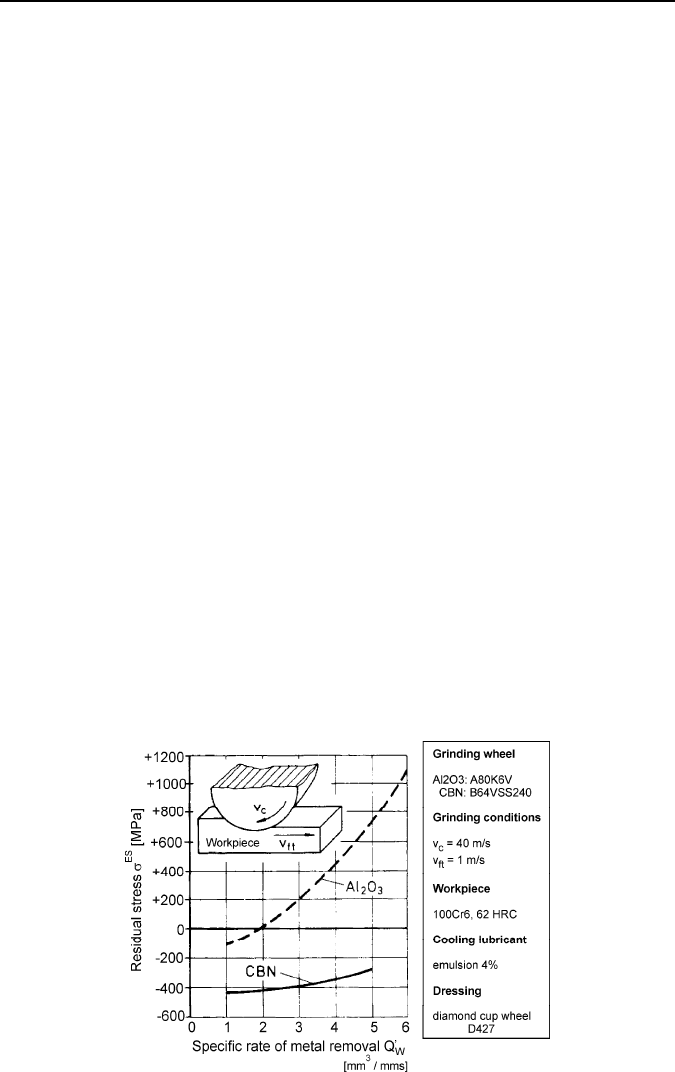
3 Residual Stresses and Microstructural Modifications 107
grinding with corundum and cubic boron nitride (CBN) and the then created sur-
face residual stresses, which were measured by X-rays. With roughly the same
surface properties, the tangential forces for both types of grinding wheels are al-
most double in the case of the corundum as compared with those of the CBN.
On the other hand, surfaces of workpieces ground with Al
2
O
3
only produced
compressive residual stresses at lower specific rate of metal removal and then
changed over to tensile residual stresses, whilst those surfaces ground with CBN
produced only compressive residual stresses.
The different forms of residual stress are partly caused by the thermal energy in-
troduced by the tangential forces and partly by the escaping of a greater part of the
thermal energy through the grinding wheel due to the high thermal conductivity of
the CBN grinding material.
Interactions between the mechanical, thermal and metallurgical state of the ma-
terial. The increasing application of high-speed machining processes requires close
investigation into mutual mechanical, thermal and metallurgical interactions in
order to prevent crack initiation by grinding or the negative influence of tensile
residual stresses on the fatigue strength of components. During grinding with ex-
tremely high speeds, the thermal portion of the frictional energy can become so
high that a martensite transformation may take place, either through self-quenching
or through coolants.
Figure 3.53 shows the distribution of the tangential residual-stress profile of a
hardened rolling bearing from the material 100 CrMn6 after a grinding. Due to the
high grinding temperatures, tensile residual stresses were released below the depth
of 50 μm, which were almost completely reduced from the outer surface region as
a result of a re-hardening zone.
Sosa et al. [41] also studied residual stresses. As opposed to the clear tendencies
observed for distortion surface stresses do not show well-defined tendencies in
relation to nodule counts and depth grinding conditions as shown in Figures
3.54(a) and (b).
Figure 3.52. Effect of the grinding wheel material on grinding forces and residual stresses in
the workpiece [40]
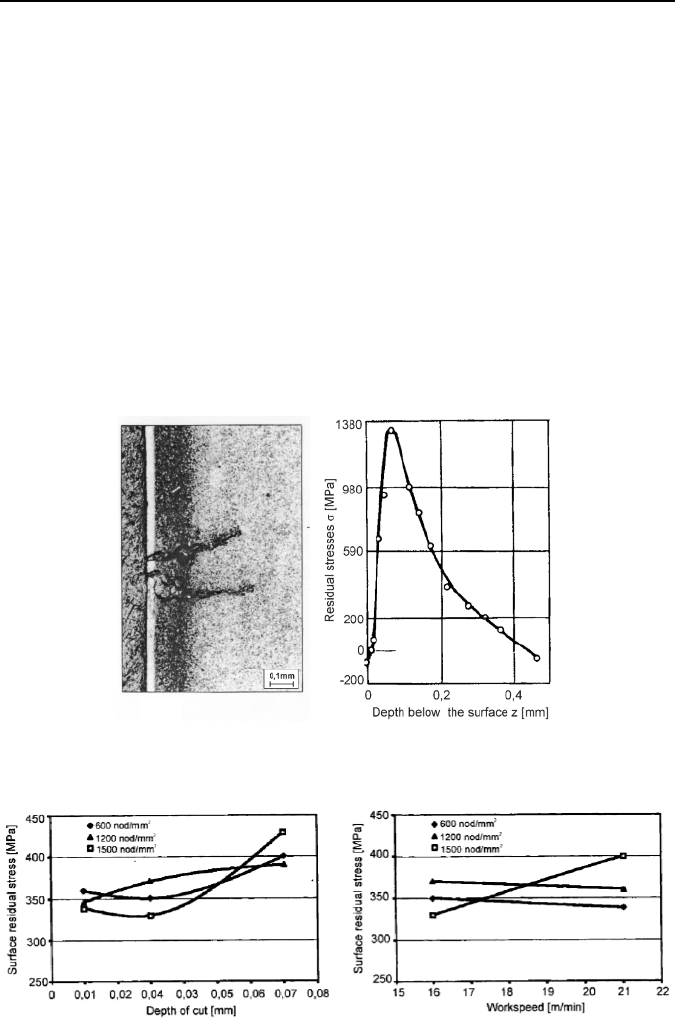
108 J. Grum
Figure 3.55 shows the profiles of in-depth residual stresses for all nodule counts
at different grinding conditions. Tensile stresses are maximum in the surface, de-
crease in the subsurface layers, and become compressive at greater depths at
0,12−0,16
mm. The arithmetic mean stress δ
m
in the tensile zone, calculated for
each stress profile, for the highest nodule counts being coherent with the greatest
distortion observed. This is in agreement with the verified correspondence between
residual stresses and distortion, caused by materials machining. Therefore, in this
study, it is consistent to adopt the mean stress δ
m
as a correlation parameter be-
tween residual stresses and distortion. The influence of nodule count on stress δ
m
can be analyzed taking into consideration the well-known thermal and mechanical
phenomena that generate residual stresses during grinding.
On the one hand, it could be supposed that tensile residual stresses resulting
from thermal effects during grinding are similar to all nodule counts.
Plastic deformation and the resulting compressive residual stresses produced by
grinding change with nodule count and modifies the mechanical properties.
Figure 3.53. Re-hardened zone and residual-stress distribution in the hardened and ground
bearing ring (material 100 CrMn 6) [40]
(a) (b)
Figure 3.54. Surface residual stress for different nodule counts as a function of: (a) depth of
cut (v
w
= 16 m/min) and (b) (a
p
= 0.03
mm; constant v
s
= 20 m/s) [41]
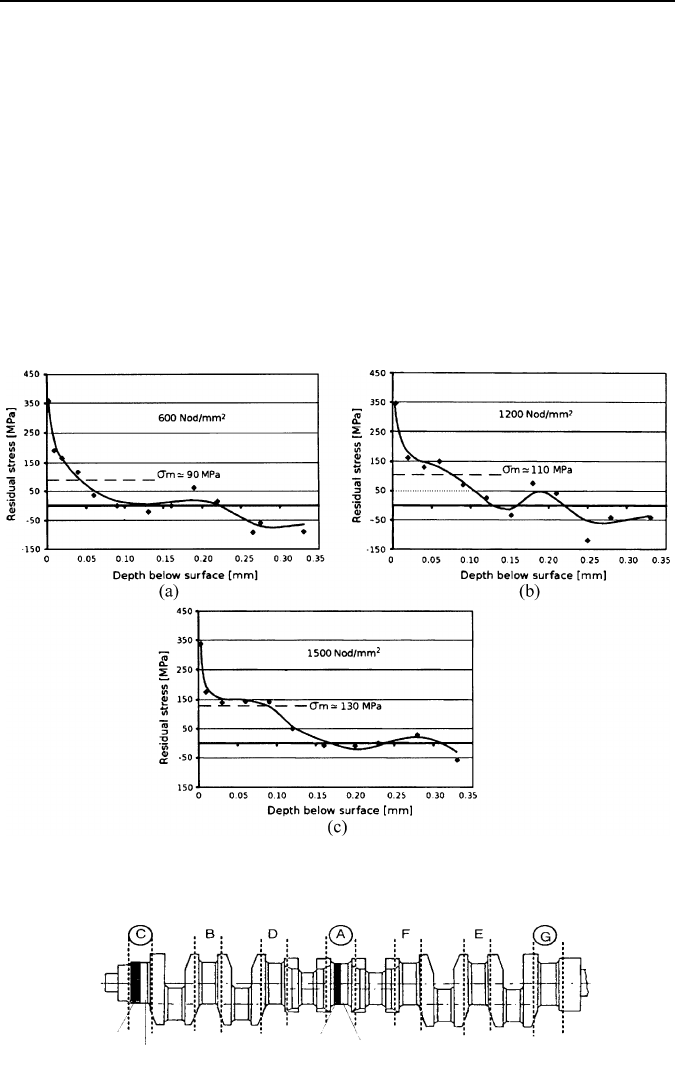
3 Residual Stresses and Microstructural Modifications 109
The fact that residual grinding stresses were tensile for all nodule counts, empha-
sizes the prevalence of thermal over mechanical effects. The greater mean stress of
the highest nodule count specimens can be attributed to a lower plastic deformation
during grinding, due to its greater hardness.
Grum and Ferlan [42] presented analysis of residual stresses in 42CrMo4 heat-
treatable steel after induction surface hardening. The residual stresses on the main
crankshaft bearings were measured on the bearing location in the middle (A), on
the extreme left side (C) and on the extreme right side (G) (Figure 3.56).
Crankshafts were taken from production after induction hardening with the heat-
treatment and machining conditions as specified in the technology sheet. For the
bearing locations A and C two specimens were taken, i.e., one on the left side of
the bearing location (A1, A2) and one on the right side (C1, C2). The bearing loca-
tion G was tested by only one specimen having a double width.
Figure 3.55. Residual-stress depth profile for each nodule count [41]
Figure 3.56. Analysis of the main crankshaft bearing after induction hardening [42]
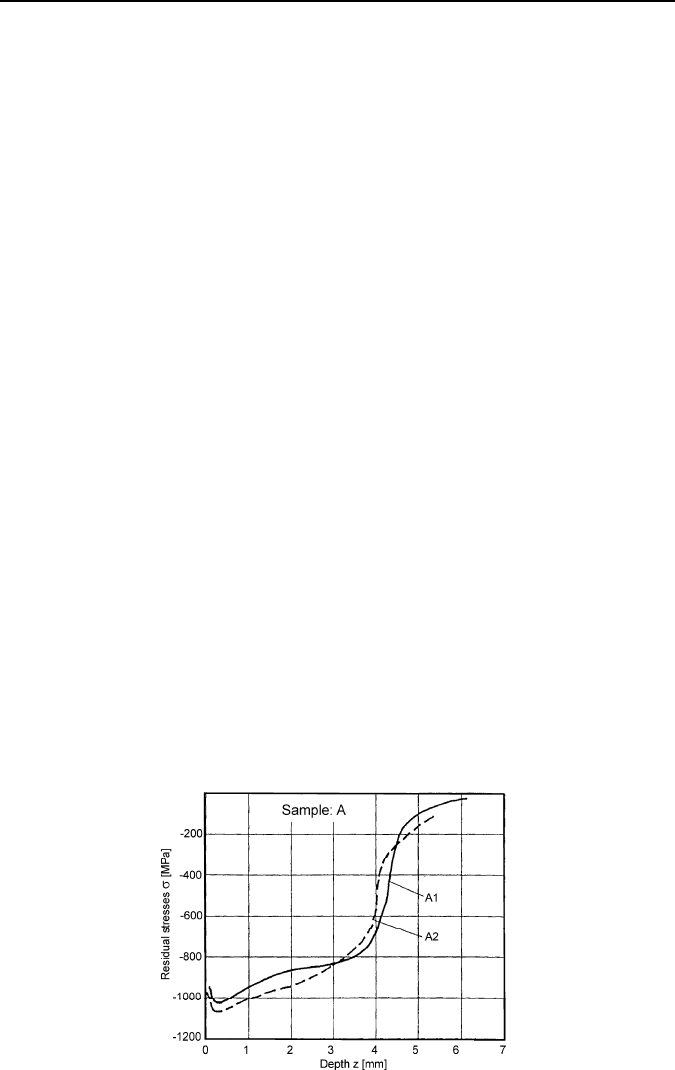
110 J. Grum
Figure 3.57 shows the residual-stress distribution after induction hardening in
the central bearing location (A). For this location residual stresses were measured
on two specimens. The distribution of residual stresses on this place is, as ex-
pected, very similar on both specimens, the highest compressive stress ranging
between 1020 to 1060
N/mm
2
in the depth around 250
μm and then slowly drop-
ping to a depth of 3.5
mm having the size of around 800
N/mm
2
, then experiencing
a sharp fall to a depth around 5.5
mm.
The last phase in the manufacturing of crankshafts is fine grinding where in or-
der to achieve the desirable condition of the surface and the surface layer [43−45],
i.e., we have to ensure:
• suitable dimensions of the particular bearing locations with respect to the allow-
able deviations (L ±ΔL);
• suitable surface roughness R
a
;
• that the grinding stresses are compressive or lowest tensile so that the favorable
stress profile obtained by induction hardening of the surface layer is maintained;
• smallest changes possible in the microstructure and thus also smallest changes in
the hardness and microhardness profiles in the heat-affected zone after grinding.
How is it possible to assure a desirable surface and surface layer quality after
induction hardening and fine grinding? Finding an answer to this question requires
a very good knowledge of the process of grinding on the microlevel as well as all
mechanical and heat effects acting on the layer of the workpiece including the type
and condition of the grinding wheel. An all-inclusive consideration of the numer-
ous influences of the kind and condition of the tool on the changes on the surface
and in the surface layer of the workpiece in the given machining conditions can be
based on the descriptions of “surface integrity”.
Figure 3.58 shows the conditions in the contact zone between the grinding
wheel surface and the workpiece surface during the process. Thus, we can define
the theoretical contact surface by the relative relation between the tool and the
workpiece. The contact surface defined in this way is then considered in the calcu-
lations of forces, amounts of removed material per unit of time, etc.
Figure 3.57. Residual-stress profile after induction hardening on the left (A1) and on the
right specimen (A2) of the main bearing location A in the centre of the crankshaft [42]
